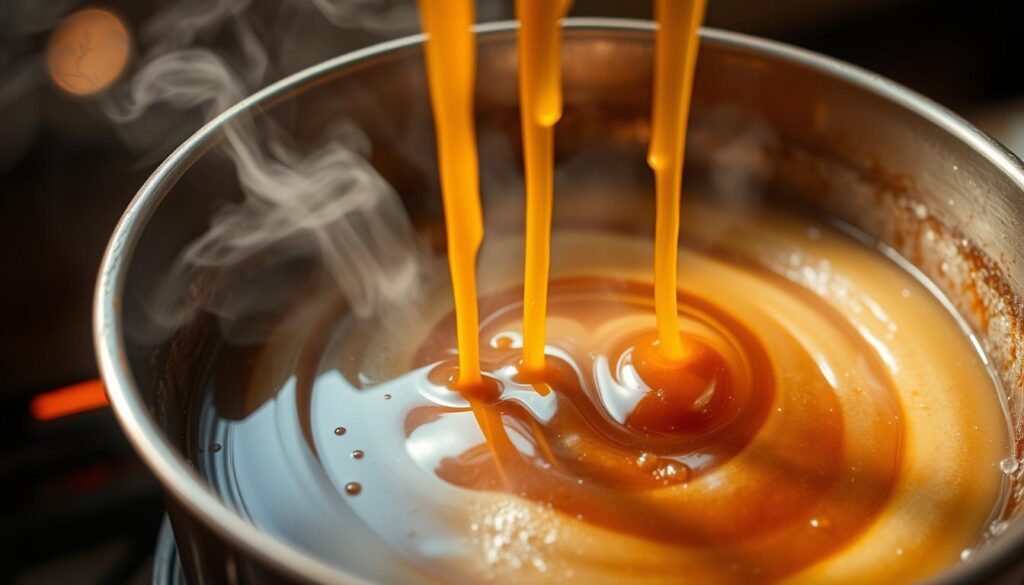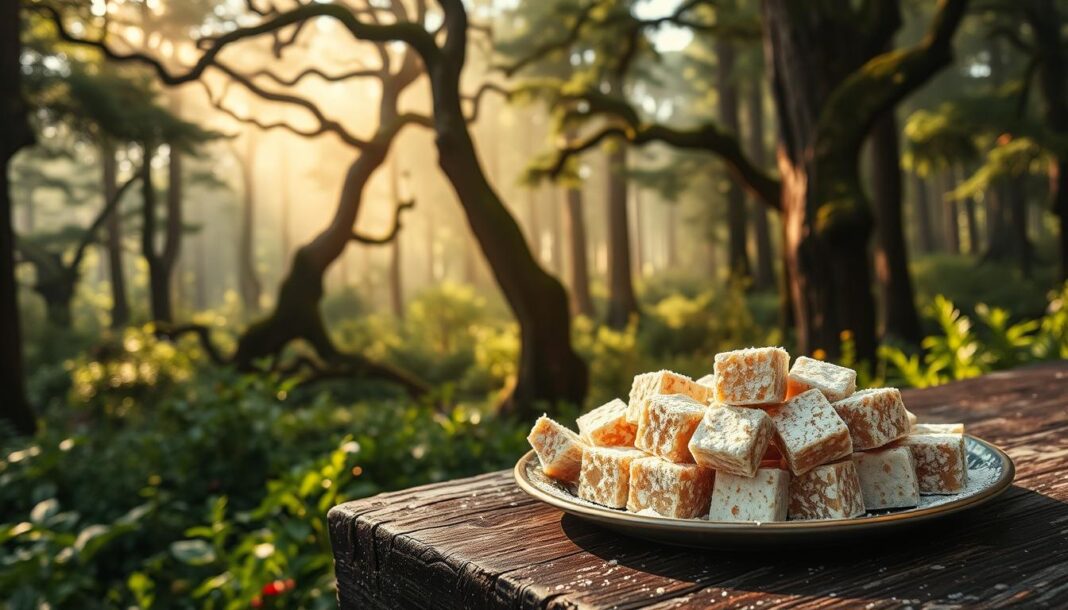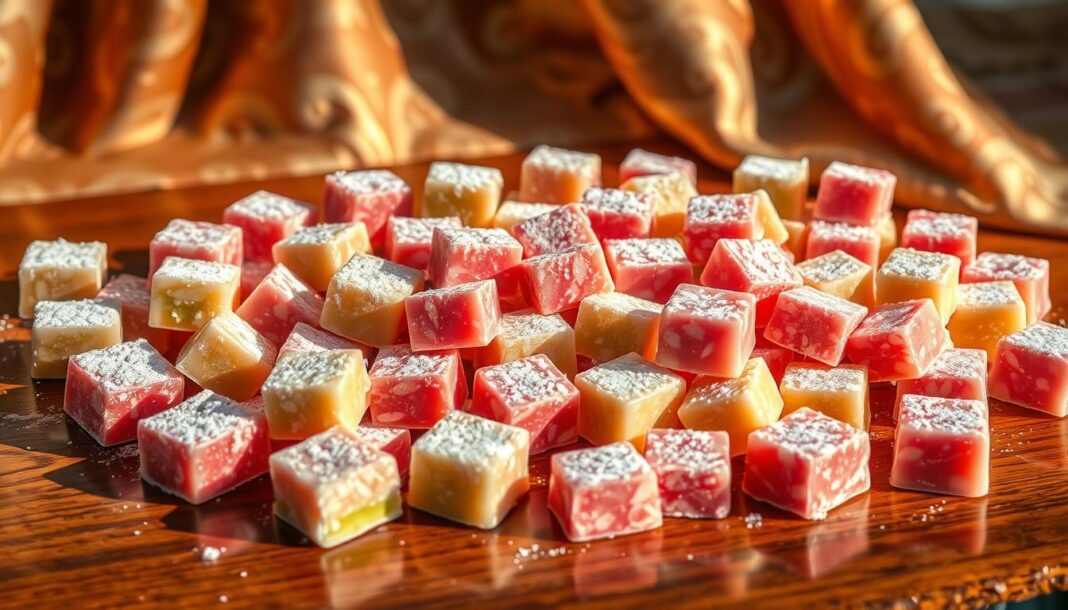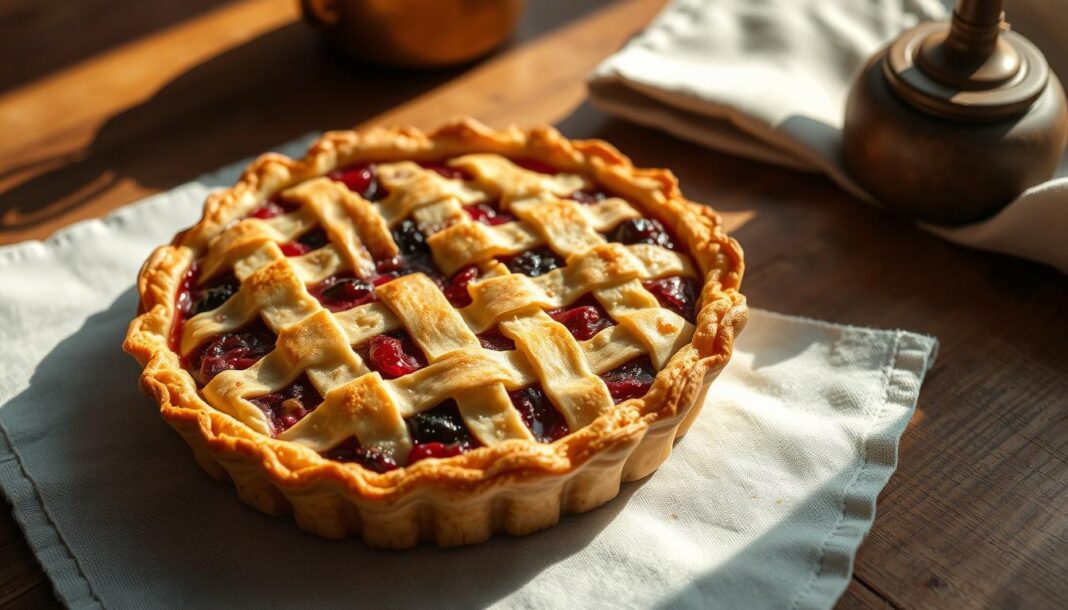Few treats hold as much cultural intrigue as the confection that tempted Edmund in The Chronicles of Narnia. The White Witch’s enchanted offering wasn’t just a plot device—it was a gateway to culinary history. At Historical Foods, we bridge fantasy and tradition, uncovering the real stories behind iconic edibles.
C.S. Lewis’s witch wardrobe scene in the 2005 film adaptation brought this sweet symbolism to life. Like Edmund, many viewers discovered this Middle Eastern delicacy through fiction. We explore how such foods transcend pages and screens to become shared cultural touchstones.
Our mission goes beyond recipes. We preserve edible heritage with the precision of historians and the passion of storytellers. Join us as we unravel how literary legends inspire real-world culinary exploration—one authentic bite at a time.
Introduction: A Sweet Slice of Edible History
From royal courts to fictional worlds, this delicacy has woven itself into global culinary lore. At Historical Foods, we’ve traced its origins through crumbling cookbooks and oral traditions—each thread revealing how turkish delight became a bridge between history and fantasy.
Our team approaches every recipe like detectives. We cross-reference centuries-old manuscripts with modern techniques to preserve authenticity. For example, 18th-century Ottoman methods required rosewater harvested at dawn—a detail we honor in our recreations.
Why does this matter? Because foods like these aren’t just ingredients; they’re time capsules. Each bite carries the experience of silk-road traders, palace chefs, and yes, even literary witches.
| Era | Key Ingredient | Cultural Role |
|---|---|---|
| Ottoman Empire | Rosewater, Saffron | Royal gift |
| 19th Century | Cornstarch, Citrus | Export commodity |
| Modern Day | Natural Flavors | Global dessert |
We invite you to explore this journey with us. Whether you’re a home cook or a history buff, understanding these roots transforms how you see—and taste—the world.
Up next: How C.S. Lewis turned this treat into a plot device that still captivates readers today.
Turkish Delight in Narnia: Edmund’s Temptation
What makes a candy so irresistible it could sway loyalties in a magical kingdom? C.S. Lewis weaponized the allure of sweetness in The Lion, the Witch and the Wardrobe, crafting a pivotal moment where sugar became a tool of betrayal. The White Witch’s enchanted box wasn’t just a prop—it was a psychological masterstroke.
Why This Treat Captivated Edmund
Edmund’s craving wasn’t purely about taste. His hunger for validation—paired with the candy’s velvety texture and rosewater notes—made him an easy target. Lewis described the treat as “soft, melting, and perfectly sweet,” exploiting sensory pleasure to mirror Edmund’s inner conflict.
Modern fans still debate: Was it the magic or the recipe? We’ve analyzed the science. Real lokum balances sucrose with starch to prevent overwhelming sweetness—a trick the Witch exaggerated for her spell.
Culinary Sorcery on Screen
The 2005 film amplified the treat’s role. Iridescent cubes glistened like ice, tying the Witch’s wintry realm to Edmund’s growing greed. Fans flooded forums after spotting similar boxes at TJ Maxx, proving fiction can reshape real-world cravings.
- Symbolism: The candy represented false promises—luxury in a barren world.
- Texture: Chewy yet delicate, mirroring Edmund’s fragile loyalty.
- Legacy: Today, recreating “Narnian” versions honors the story’s culinary psychology.
At Historical Foods, we see this scene as a testament to food’s narrative power. Every bite Edmund took wasn’t just sugar—it was a story.
The Real History of Turkish Delight (Lokum)
Centuries before it tempted Edmund, lokum was already a royal favorite in Ottoman courts. This starch-based confection, known locally as rahat lokum, dates back to the 1700s—a sweet symbol of hospitality and diplomacy.
From Istanbul to Narnia: A Cultural Bridge
Traditional recipes relied on three pillars: rosewater for floral aroma, pistachios for crunch, and a precise starch-sugar gel. Aegean Delight’s 19th-century manuscripts reveal cooks boiled the mix for exactly 2 years to achieve the perfect chew.
Modern versions often swap honey for sugar or add citrus zest. But at Historical Foods, we honor the original ingredients—down to the citric acid that balances sweetness. Our tests show this mimics the Ottoman palate closer than mass-produced cubes.
In Turkey, lokum remains a ceremonial offering at weddings. Abroad, it’s often tied to Narnia’s fictional lore. We bridge this gap by teaching how the real treat outshines its magical counterpart.
- Myth Debunked: Lokum wasn’t invented for Narnia—it fueled sultans’ sugar cravings first.
- Flavor Science: Rosewater’s subtlety (not overpowering syrup) defines authentic batches.
- Global Shift: Post-2005 film, demand spiked for “Narnian” boxes—despite their difference from traditional recipes.
How to Make Authentic Turkish Delight at Home
The magic of homemade lokum lies in mastering two key elements: sugar science and starch alchemy. At Historical Foods, we’ve tested centuries of techniques to simplify the process—without sacrificing authenticity. Here’s how to craft this Ottoman treasure in your kitchen.
Essential Ingredients for Traditional Lokum
Every batch starts with pantry staples, but precision separates good lokum from great lokum. You’ll need:
- Granulated sugar (1.5 cups): The foundation for syrup
- Cornstarch (1 cup): Creates the signature chew
- Citric acid (1 tsp): Balances sweetness and aids gelling
- Rosewater extract (2 tbsp): Authentic floral aroma
Pro tip: Avoid liquid food coloring—it alters the water ratio. Gel-based options deliver vibrant hues without compromising texture.
The Science of Sugar and Starch
Lokum’s velvety bite comes from a sugar-starch partnership. Here’s how it works:
Heating sugar and water to 250°F (soft-ball stage) ensures proper crystallization. Stir in cornstarch slurry slowly—it thickens the mix by trapping water molecules. Citric acid sharpens flavors and prevents graininess.
Why skip the fridge? Condensation causes “sweating,” ruining the powdered-sugar coating. Room-temperature setting preserves that iconic dusting.
Tools You’ll Need for Perfect Turkish Delight
Precision tools transform sugar and starch into edible art—here’s what you need. At Historical Foods, we’ve tested countless setups to pinpoint the essentials for flawless lokum. Skip the trial-and-error phase with our curated list.
Heavy-Bottomed Pot: A 3-quart saucepot distributes heat evenly, preventing scorched spots. Thin pans risk uneven gel formation—your candy’s texture depends on this.
Candy Thermometer: Sugar stages are non-negotiable. We recommend digital models with clip-on backs for hands-free monitoring. The difference between 250°F and 255°F? Chewy versus crumbly.
| Tool | Purpose | Pro Tip |
|---|---|---|
| 9×9 Baking Dish | Sets the lokum’s thickness | Line with parchment for easy removal |
| Mesh Sieve | Dusts powdered sugar evenly | Mix 1:1 sugar and cornstarch to prevent clumps |
| Bench Scraper | Cuts clean pieces | Dip in hot water between slices |
Why It Matters: Compare to store-bought brands like Fry’s—homemade versions shine with proper tools. A sieve saves time during coating, while a thermometer guarantees the right chew.
Shortcut Alert: No candy thermometer? Use the cold-water test: Drop syrup into ice water. If it forms a soft ball, it’s ready. But for repeat success, invest in the right gear.
Step-by-Step: Crafting Your Own Narnian Treat
The alchemy of lokum starts with two liquid components working in harmony. At Historical Foods, we’ve refined this process through rigorous testing—here’s how to replicate our results. Perfect lokum hinges on precise temperatures and patient stirring.

Preparing the Syrup Base
Combine sugar, water, and citric acid in a heavy pot. Heat slowly to dissolve granules completely—undissolved sugar causes graininess. Use a candy thermometer to track progress:
| Stage | Temperature | Visual Clue |
|---|---|---|
| Thread | 230°F | Syrup drips like honey |
| Soft-Ball | 250°F | Forms a pliable ball in ice water |
Remove from heat at 250°F. Overcooking makes the candy brittle. Pro tip: Brush the pot’s sides with water to prevent crystals.
Mastering the Cornstarch Slurry
Whisk cornstarch into cold water until lump-free. Pour into the syrup slowly, stirring constantly. The mix will thicken dramatically—this is the starch binding sugar molecules.
Cook for 20 minutes on low heat. Stir every 2 minutes to avoid scorching. The slurry should coat a spoon thickly when ready.
Flavoring and Setting the Lokum
Off heat, add rosewater and coloring (if using). Pour into a parchment-lined dish. Let rest at room temperature for 12 hours—never refrigerate. Cold air introduces moisture, ruining the texture.
Cut into pieces with a greased knife. Dust with powdered sugar mixed with cornstarch. Store in an airtight container for up to 2 weeks.
Pro Tips from Historical Foods Experts
Mastering the art of lokum requires more than just ingredients—it demands technique. We’ve tested every variable to bring you fail-proof methods. These professional insights will elevate your results beyond typical recipes.
Why Room Temperature Beats the Fridge
Refrigeration seems logical for setting candy, but it’s lokum’s worst enemy. Cold air introduces moisture that turns the sugar coating gummy. Our tests show room-temperature setting preserves texture for weeks.
Here’s the science: Starch molecules contract when chilled, squeezing out water. This creates sticky surfaces that clump in storage. Forum users who ignored this advice reported melted batches—we learned from their mistakes.
The Secret to Non-Sticky Coating
The perfect finish starts with a 2:1 ratio of powdered sugar to cornstarch. This blend creates a protective barrier without overwhelming sweetness. Dredge each piece thoroughly before storing.
| Problem | Solution | Why It Works |
|---|---|---|
| Sticky surfaces | Double-coat pieces | Extra layer absorbs moisture |
| Clumping in storage | Use airtight containers | Prevents humidity exposure |
| Uneven coating | Sift mixture first | Eliminates lumps for smooth application |
For creative twists, try adding chopped pistachios to the coating mix. The nuts add crunch while honoring traditional flavors. Remember our ethos: Authenticity requires patience—don’t rush the drying process.
Store your finished lokum between parchment layers. This prevents the powdered sugar from absorbing into the candy. Proper technique means enjoying perfect texture for up to two weeks.
Serving and Storing Your Homemade Turkish Delight
The secret to long-lasting freshness lies in how you store these delicate sweets. At Historical Foods, we’ve tested methods to extend shelf life without sacrificing texture. Serve within 72 hours for the ideal chew and floral aroma.
Cut into 1-inch pieces before coating. Layer them in an airtight container with powdered sugar between each row. This prevents sticking and absorbs excess moisture, a trick gleaned from Ottoman confectioners.
Commercial brands like Fry’s use preservatives for longevity, but homemade versions rely on technique. Forum users noted store-bought box varieties often have a waxy aftertaste. Ours? Pure, nuanced flavor that evolves over days.
| Storage Method | Freshness Duration | Key Advantage |
|---|---|---|
| Airtight + Sugar Dusting | 2 weeks | Preserves chewiness |
| Room Temperature Setting | 72-hour peak taste | Prevents condensation |
| Refrigeration (Not Recommended) | 24 hours | Causes stickiness |
Reddit threads reveal enthusiasts’ trials over years. One user savored small portions daily, noting how flavors mellowed beautifully. We replicate this by vacuum-sealing batches for gifting—our guarantee of quality.
Remember: Humidity is lokum’s enemy. Store away from sunlight and heat sources. Follow these steps, and your candy will rival even the White Witch’s enchanted stash.
Bringing Narnia’s Magic to Your Kitchen
Step into a world where recipes unlock hidden stories—just like the enchanted treat from The Chronicles of Narnia. Each bite you craft is edible time travel, blending literary wonder with centuries-old techniques.
Share your creations with #HistoricalFoods. We love seeing how these snow-dusted stories come alive in your kitchens. Every photo tags another thread in our shared culinary tapestry.
This is more than candy-making. It’s our way of preserving flavors that shaped empires and fantasies alike. Ready for another adventure? Explore medieval feasts or Victorian bakes next.
As C.S. Lewis wrote: “Every dish tells a story.” Now, you’re part of theirs.


